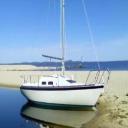Yahoo Answers is shutting down on May 4th, 2021 (Eastern Time) and beginning April 20th, 2021 (Eastern Time) the Yahoo Answers website will be in read-only mode. There will be no changes to other Yahoo properties or services, or your Yahoo account. You can find more information about the Yahoo Answers shutdown and how to download your data on this help page.
Trending News
why is a Jib not a jib?
Several answers here have said the the foresail on a typical sloop is not really a jib. I wish those people would explain their position. A jib since the time of square riggers is the sail that is forward of the fore most mast, connected to a fore stay.
I agree with you trunorth. Genoa's and other sails where the foot extends beyond the mast are foresails, not jibs. A genoa being the largest at about 1 1/2 times the length of the jib.
5 Answers
- ricsudukaiLv 61 decade agoFavorite Answer
This actually intrigued me as well - I spent a few hours and a few phone calls to resolve my own position.
A jib is a triangular foresail. It would be the sail(s) most forward of the forward mast. (on multi-masted vessels) There can be several, or one, or any number within reason. They will be on stays leading from the most forward point on the hull or bowsprit to the highest practical point on the mast.
There is reference to jibs historically at least back to the 1600's in the english language. I just quickly grabbed a copy of Master and Commander by Patrick O'Brian and in the first few pages I am looking at an image of a square rigged ship of around the mid 1700's with all sails hung out to dry in a calm, the flying jib is most forward with the Jib behind that, then comes the Fore topmast staysail, there is another furled sail between that of unclear purpose (probably a square course to be hung beneath the bowsprit on a yard just visible and then a Fore staysail hung from well back down the bow sprit to half way up the foremast. (This image is credited to the Serres, Liber Nauticus. Courtesy of The Science and Technology Research Center, The New York Public Library, Astor, Lenox, and Tilden Foundation.)
Having had several conversations with Pep Manthorpe in his later years (Master mariner and Commander of the Endeavor replica on it's first global voyages, his son is/was master of the Dyfken on some of it's voyages) He would always refer to the jib(s) as the most forward sails, and a staysail would always be hanked to a stay mounted further down the mast than the forestay mounted jib(s)
The distinction between a jib being mounted on a bowsprit or not seems to have much more to do with if the boat has a bowsprit in the first place, rather than having to have a bowsprit in order to call the foresail a jib.
It would be fair to say when talking of a square rigged, or other multi-masted and canvassed vessel that a distinction should be made in the individual names of sails of similar configuration and location. But it is equally true that it is completely irrelevant to attempt this individual labeling when talking of a very simple two or three sail fore and aft rig.
The majority of people have never had anything to do with much more the a basic dinghy rig, and no sail maker in the world will mistake your intention when you ring them up and ask for a jib!
A Genoa is a jib that extends back past the mast next to the front part of the mainsail on a Bemudan, Ketch etc. rig. A jib should it have a boom mounted to it will be able to tack in front of the mast if no jackstay fitted (that is a stay mounted from the deck partway between the foot of the mast and the bow, and then going about half to two thirds up the mast) A sail mounted to a jackstay will be referred to as a staysail still today. Unless you have two or more masts you could not mount any other staysail.
It is a debate over semantics in the modern context, I appreciate the pure intent of the terms but fail to see that it will create anything but confusion unless these terms are applied to the appropriate class of vessel.
Edit
I enjoyed most of the links of 'threesheave', although the first link accused me of stealing bandwidth or something. I guess my 34 footer is the only yacht I own that has jibs now, all the others will have to do with headsails from now on.
I wonder if they will notice the change........ :)
- threesheaveLv 51 decade ago
I'm those people and I'm not alone. If enough people call something the wrong thing for enough time, does that make it right?
If you called the turn signal lights on the front of a car, headlights, would they really be headlights, since they are on the front of the vehicle?
How many people think that any large sailing vessel is a ship? Most of them, including a lot of 'sailors'. There are many differences between ships, barks, barkentines, brigs, brigantines, schooners, ketchs, yawls, and sloops, but their sails are almost always called the same thing, regardless of vessel type.
Sails on any sailing vessel are generally named after what they are attached to.
The asker is wrong that a jib is attached to a forestay. You are also wrong to call any sail on a sloop, a foresail. Only vessels with two or more masts have foresails, square rigged or not. They have been called headsails since the 16th century.
A forestay sail is attached to a forestay, which is what every sloop without a bow sprit has.
If a vessel has a bow sprit and a headsail tack is bent to the sprit, then it is a jib. (as long as it's not attached to the forestay)
If a vessel has a forestay sail, and more than one jib, then they are named, from aft to fore, jib, inner jib, outer jib, and flying jib. Vessels with more than one jib usually have a jib boom.
If the vessel has a fore topmast, the sail attached to the fore topmast stay is just that, a topmast staysail, but some folks call them a jib topsail. It's not a jib though.
If your sloop is cutter rigged, it would have a forestay sail and a jib. Genoa's are nearly always forestay sails, but gained a new name for their difference in size and cut. They are still forestay sails if they are attached to the forestay.
Look up jib on Wikipedia, it's wrong. It was written by someone that didn't do their homework and grew up hearing all headsails being called jibs.
Sailing is about tradition. Read some books that were written in the 1800's or early 20th century about sailing. You'll learn something.
You guys go right ahead and call your sails whatever you like, but in the end, sloops don't carry jibs. Cutters do.
Here's a few links to diagrams, most of which are from old books, not the newfangled slang of today.
Edit: First, I apologize for the bad link. I tried to do an end run around it and provided a link directly to the larger image so that you wouldn't have to download it. That didn't work, so I've changed the link. You will have to download the image to see it in full scale.
Second, I apologize for causing such a stink, but I hate for people to be misinformed, but mostly I hate for people to misinform others.
So....
I'll say it again, if a sail is bent to a stay, it's a staysail. It doesn't matter if the vessel is rigged fore and aft or square rigged, the names of sails have always been the same regardless of vessel type.
The difference is actually between standing rigging and running rigging.
A foresail is only found on the aft side of a foremast (fore and aft rig) or bent to the foreyard (lowest yard on the foremast, square rigged)
Schooners, ships, barks, brigs and other vessels have foresails, but not sloops, cutters, ketches and yawls.
At least call them headsails if you don't know what their names are.
Many sails have specific names and aren't named after what they are attached to. Here's a short list.
Genoa, spinnaker, fisherman, raffee, spanker (driver), skysail, moonraker...
If your roller furled headsail isn't on a stay, then call it a jib. Call it whatever you want.
Would you call an orange an apple, just because it's in the same box and they are both fruits?
We call masts, masts, booms, booms, tillers, tillers, cockpits, cockpits, bathrooms, heads, sheets, sheets, walls, bulkheads, and we call the floor, a deck. Why not call ALL the parts of a boat by their actual names?
Because 'forestaysail sheet' is harder to say than 'jib sheet' and people just don't care any more or don't know.
Would you want to fly with a pilot that called the ailerons, flaps? Or the yoke, a steering wheel?
In the end, we don't boat. We sail. Our powerboat brethren don't have a clue about sails or their names. We should at least know proper terminology.
Go sailing guys and have fun! None of this really matters. It's just Yahoo!
http://shipmodeling.info/schooner.htm
http://www.all-model.com/wolfram/PAGE34.html
http://www.fatefulvoyage.com/masts/mastsNames.html...
- KiloLv 41 decade ago
ok so whats in a name in the real old days the foresail was a square sail The term jib is used in reference to the triangular sail. "Jib" makes it hard to mistake which sail is being refered to
A foresail is one of a few different types of sail set on the foremost mast (foremast) of a sailing vessel:
·A fore and aft sail set on the foremast of a schooner or similar vessel.
·The lowest square-sail on the foremast of a full rigged ship or other vessel which is square-rigged.
Sails set forward of the foremast, such as jibs and staysails, are sometimes referred to as foresails, although "headsails" is a more common term.
forestay is the stay that runs from the top of the mast to the bowsprit
I have seen roller furling sails that were not attached to or acted as a forestay what are these called ??????
Edit
Nomenclature evolves over time and is adapted to refer to an object or devise that serves the same purpose as the original take WeedEater( the name given to the first and original line trimmer). We use the term weed eater to refer to all monofilament line trimmers. But no all monofilament line trimmers are weed eaters. Only the ones that carry the brand name WeedEater are weedeaters
go enjoy being on the water
Source(s): http://en.wikipedia.org/wiki/Foresail - trunorthLv 61 decade ago
Well, I have been sailing jib rigged sloops for 25 years, and I was taught the name of the foresail is: jib.
Would some people like to call it a genoa, or jennie?
What others names would our fellow forum participants like to call it?
Source(s): Inland waters guru and former sailing instructor - How do you think about the answers? You can sign in to vote the answer.
- MAVERICKLv 41 decade ago
I think the whole question is just silly,the "correct" names of sails is totally academic.The origin was with square-rigged vessels and you are trying to apply them to fore and aft rigs .Just get out there and sail while you can.
Source(s): Many years sailing.




